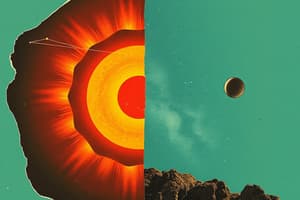Podcast
Questions and Answers
If a spectral line from a distant galaxy exhibits a redshift of z = 0.1, approximately what is the galaxy's velocity relative to us?
If a spectral line from a distant galaxy exhibits a redshift of z = 0.1, approximately what is the galaxy's velocity relative to us?
- 3,000 km/s moving towards us
- 300,000 km/s moving away from us
- 30,000 km/s moving away from us (correct)
- 3,000 km/s moving away from us
Which sequence correctly orders the layers of the Sun from the innermost to the outermost?
Which sequence correctly orders the layers of the Sun from the innermost to the outermost?
- Photosphere, Chromosphere, Corona, Radiative Zone
- Core, Convection Zone, Photosphere, Chromosphere
- Core, Radiative Zone, Convection Zone, Corona
- Core, Radiative Zone, Convection Zone, Photosphere (correct)
Considering the stellar classification sequence O, B, A, F, G, K, M, which of the following statements is most accurate?
Considering the stellar classification sequence O, B, A, F, G, K, M, which of the following statements is most accurate?
- M stars are cooler and have shorter lifespans than O stars.
- M stars are hotter and have shorter lifespans than O stars.
- O stars are hotter and have shorter lifespans than M stars. (correct)
- O stars are cooler and have longer lifespans than M stars.
Which of the following characteristics is most typical of elliptical galaxies?
Which of the following characteristics is most typical of elliptical galaxies?
What event allowed photons to travel freely through the universe, leading to the formation of the Cosmic Microwave Background Radiation (CMBR)?
What event allowed photons to travel freely through the universe, leading to the formation of the Cosmic Microwave Background Radiation (CMBR)?
Flashcards
Sun's Core
Sun's Core
The Sun's core is where nuclear fusion occurs, converting hydrogen to helium and releasing vast amounts of energy.
Sunspots
Sunspots
Sunspots are cooler, darker areas on the Sun's photosphere caused by intense magnetic activity.
Redshift and Blueshift
Redshift and Blueshift
Redshift indicates an object is moving away from us, while blueshift means it's moving towards us.
Star Classification
Star Classification
Signup and view all the flashcards
Types of Galaxies
Types of Galaxies
Signup and view all the flashcards
Study Notes
- The Sun consists of multiple layers.
Solar Layers
- Core: Nuclear fusion takes place.
- Radiative Zone: Energy moves outward via radiation.
- Convection Zone: Hot gases rise, cool gases sink.
- Photosphere: The Sun’s visible surface.
- Chromosphere: Located just above the photosphere.
- Transition Region: Connects the chromosphere to the corona.
- Corona: The Sun’s outermost layer, visible during eclipses.
Solar Features
- Sunspots: Dark, cooler areas on the surface caused by magnetic activity.
- Coronal Holes: Less dense regions where solar wind escapes.
- Solar Flares: Sudden bursts of energy.
- Prominences: Loops of plasma extending from the Sun.
Redshift and Blueshift
- Redshift: Indicates an object is moving away, positive z-value.
- Blueshift: Indicates an object is moving toward us, negative z-value.
- Velocity Calculation: v = z × c, where c = 300,000 km/s.
Star Classification
- Star Sequence: O, B, A, F, G, K, M.
- O Stars: Hottest, blue, shortest-lived.
- M Stars: Coolest, red, longest-lived.
Nucleosynthesis and CMBR
- Nucleosynthesis: Occurred 3 minutes post-Big Bang, forming hydrogen and helium nuclei.
- CMBR: Electrons bonded to nuclei 380,000 years post-Big Bang, allowing light to travel freely.
The Big Bang
- Age: 13.8 billion years ago.
- Initial Temperature: 10³² K.
- Later Temperature: Cooled to 10¹² K.
Galaxy Types
- Spiral: Active star formation, e.g., Milky Way.
- Elliptical: Older stars, little gas or dust.
- Irregular: Formed from galaxy mergers, rapid star formation.
Studying That Suits You
Use AI to generate personalized quizzes and flashcards to suit your learning preferences.
Description
Explore the layers of the Sun, including the core, radiative zone, and corona. Learn about solar features like sunspots and flares. Understand redshift, blueshift, and star classification.




